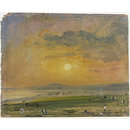What do we do with our blogs? When we borrow from each other, allude to each other, even cite each other, are we a mutual admiration society, patting each other on the back? I don’t think so. What happens – what we hope will happen – is that we will then venture further and find more art, more inspiration and more creativity. It’s not that we are copying what our fellow has done, it is that what our friend has done reminds us of something we might do. So let’s call it the interconnectedness of things. Synergy if you please.
I have an example. My friend Rob, the creator of the wonderful Hammock Papers, posted this great Bobby McFerrin video. But what struck me was the McFerrin interview, when Bobby says, “When I was a kid growing up and we bought albums, we treated them with such reverence, we would listen to every single cut, first to last, whether we liked the pieces or not, we were patient enough to at least give the [pieces] a chance.”
I read this from Rob’s blog the very same day that I had read an oddly similar thing in Just Kids, by Patti Smith. Smith is relating the experiences of herself and Robert Mapplethorpe at twenty years old. Both will become famous avant garde artists, but at this point, they are “just kids” in New York with big dreams but no TV, no radio and no money. Here is the excerpt from Just Kids.
When music is used for the appreciation of it, and not just as background noise, you get Bobby McFerrin, and you get this:




